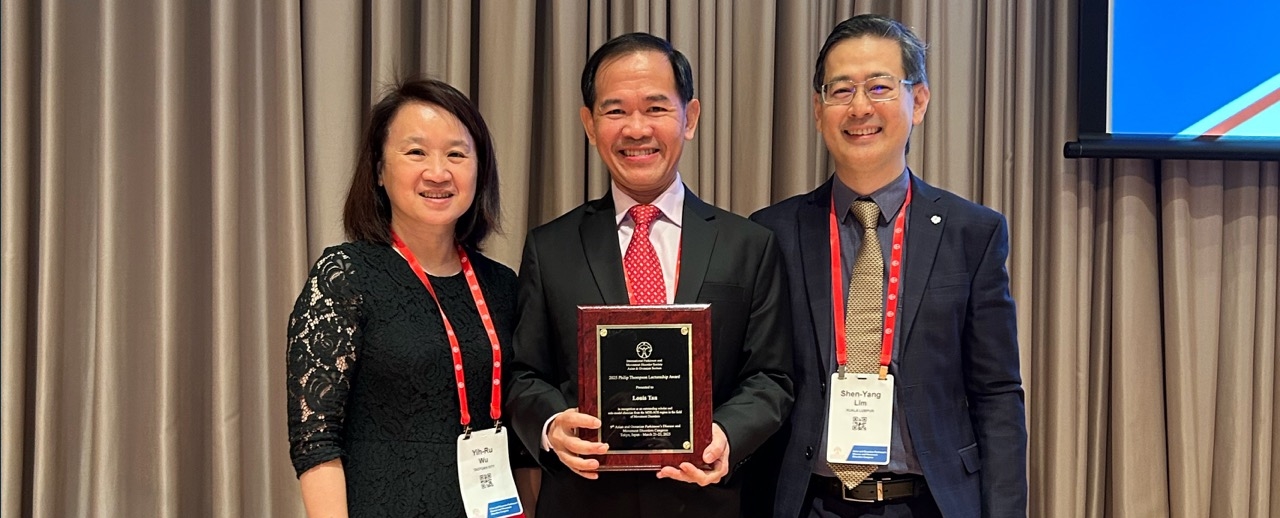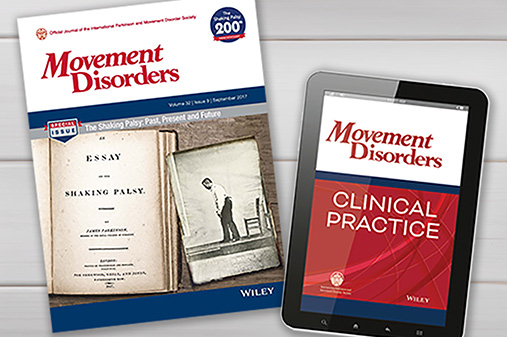 VOLUME 29, ISSUE 2 • JUNE 2025. Full issue »
VOLUME 29, ISSUE 2 • JUNE 2025. Full issue »


It was my great pleasure and honour to receive the Philip Thompson Lectureship award at the Asian and Oceanian Parkinson’s Disease and Movement Disorders Congress (AOPMC) in Tokyo, Japan, on March 23, 2025. Prof. Thompson is a master clinician, astute researcher, and outstanding leader. He is one of the pioneers of the Asian-Oceanian Section (AOS) and was as its first Chair in 2006. He was also the first MDS President from the AOS, serving between 2009 to 2011.
The title of my talk at the lectureship was “Progression of Parkinson Disease.” As PD is a chronic neurodegenerative disease with many patients living for decades with the condition, it is important to know and understand the disease course, and factors that influence its progression. The progression of PD is most commonly studied using the Hoehn and Yahr (HY) staging or the Unified PD rating scale (UPDRS or MDS-UPDRS). Studies of this nature require long-term prospective follow-up of patients that require much time, commitment, and resources.
We had previously used a large database to understand how long it took for patients to progress from one HY stage to another. We found that on the average it took approximately 2 years to transit between HY stages 1 to 2, 2.5 to 3, 3 to 4, and 4 to 5. Between HY stage 2 and 2.5 it took about 5 years. Various factors influenced these transition times, including higher UPDRS motor scores, older age at diagnosis, and increased disease duration.1 We also found that patients who were treated on Sselegiline for 3 years or more experienced a longer transition time between HY stages 2 to 2.5 and 2.5 to 3, suggesting a possible disease- modifying effect of this drug.2
Our studies on PD motor progression using UPDRS motor scores showed that progression was non-linear. There was an improvement in UPDRS motor scores as a result of initial treatment up to the fourth4th to fifth5th year of disease. Following which, the scores exceeded the baseline UPDRS motor scores and progressed incrementally. Male sex, older age at diagnosis, akinetic-rigid subtype, cognitive impairment, and lower baseline motor scores had significantly greater motor score progression up to 9 years of follow-up.3 LRRK2 Asian risk variant carriers also had a greater rate of motor progression compared to non-carriers after 4 years from the date of diagnosis.4
Over the past decade, PD subtyping using data-driven hierarchical cluster analysis hasve been performed. We performed such an analysis in our local Asian population and identified 3 subtypes. Cluster A was the severe subtype in motor, non-motor symptoms, and cognition. Cluster B was an intermediate subtype with moderate cognitive impairment and mild non-motor symptoms, while cluster C was a mild subtype with younger age of onset. Various biomarkers were found to characterise these subtypes. Two genotypes from the Asian GWAS meta-analysis, Park16 rs6679073 and SV2C rs246814, were found to be significantly more common in cluster C. On the other hand, the blood biomarkers homocystine and C-reactive protein levels were significantly higher in the more severe cluster A.5
Longitudinal follow- up of these subtypes over 5 years showed that cluster A had significantly faster progression in non-motor scores for mood/apathy, perceptual problems, and urinary scores. Cluster A also progressed significantly in the PIGD motor score. For cognitive outcomes, cluster A deteriorated significantly in the visuospatial domain, whereas cluster C deteriorated significantly in the executive domain.6
Future directions to improve the study and understanding of PD progression will include: |
|
References
-
YJ Zhao, HL Wee, YH Chan, SH Seah, WL Au, PN Lau, EC Pica, SC Li, N Luo and LCS Tan. Progression of Parkinson’s Disease as Evaluated by Hoehn and Yahr Stage Transition Times. Mov Disord 2010; 25(6):710-716.
-
YJ Zhao, HL Wee, WL Au, SH Seah, N Luo, SC Li, LCS Tan. Selegiline is associated with a slower progression in Early Parkinson’s Disease as Evaluated by Hoehn and Yahr Stage Transition Times. Parkinsonism and related disorders 2011;17:194-197. Erratum in: Parkinsonism Relat Disord. 2011 May;17(4):299-300.
-
Giselle Reinoso, John Carson Allen, Wing-Lok Au, Soo-Hoon Seah, Kay-Yaw Tay, Louis CS Tan. Clinical evolution of Parkinson’s disease and prognostic factors affecting motor progression: 9-year follow-up study. Eur J Neurol 2015 Mar;22(3):457-63.
-
Linda P. Oosterveld, John C. Allen Jr, Ebonne Y.L. Ng, Soo-Hoon Seah , Kay-Yaw Tay, Wing-Lok Au, Eng-King Tan, Louis CS Tan. Greater motor progression in Parkinson’s disease patients with LRRK2 risk variants. Neurology. 2015 Sep 22;85(12):1039-42.
-
Deng X, Saffari SE, Liu N, Xiao B, Allen JC, Ng SYE, Chia N, Tan YJ, Choi X, Heng DL, Lo YL, Xu Z, Tay KY, Au WL, Ng A, Tan EK, Tan LCS. Biomarker characterization of clinical subtypes of Parkinson Disease. NPJ Parkinsons Dis. 2022 Aug 29;8(1):109.
-
Deng X, Saffari SE, Xiao B, Ng SYE, Chia N, Choi X, Heng DL, Ng E, Xu Z, Tay KY, Au WL, Tan EK, Tan LCS. Disease Progression of Data-Driven Subtypes of Parkinson's Disease: 5-Year Longitudinal Study from the Early Parkinson's Disease Longitudinal Singapore (PALS) Cohort. J Parkinsons Dis. 2024;14(5):1051-1059.
Read more Moving Along:






